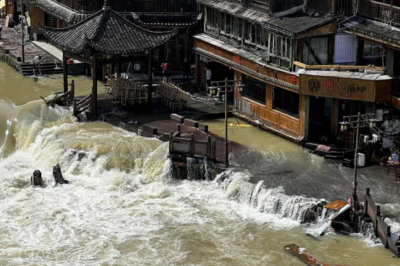
A recent scientific study has unveiled alarming findings about the subsidence of land under major Chinese cities, putting millions at risk of flooding due to rising sea levels and urban sinkage. Published in the journal Science on April 18, the research highlights a critical issue facing nearly half of China’s urban areas, affecting approximately 270 million people.
Key Insights from the Study on Urban Subsidence in China:
- Widespread Subsidence: The study reports that about 29% of China’s population, living in urban areas, resides on land subsiding more than 3 millimeters (about 0.12 inches) per year. This widespread phenomenon exacerbates the threat of sea-level rise, particularly in coastal regions.
- Severe Cases: Alarmingly, around 67 million people are living in zones where the ground is sinking over 10 millimeters (0.4 inches) annually. These areas are experiencing significantly faster rates of subsidence, which could lead to more immediate and severe consequences.
- Causes of Subsidence: One of the primary drivers of this subsidence is the extensive withdrawal of groundwater. Cities are extracting water from underground aquifers at rates faster than they can be replenished, a situation worsened by climate-induced droughts. Additionally, the sheer weight of urban infrastructure contributes to the sinking as buildings and roads compress the underlying soil.
- Global Comparisons and Implications: The issue of land subsidence is not unique to China; it is a global concern affecting numerous coastal cities around the world, including New York, the Netherlands, and Mexico City—the latter experiencing subsidence rates up to 50 centimeters (nearly 20 inches) per year. These comparisons highlight the urgent need for global attention and action to mitigate such risks.
- Potential Flood Risks: The study warns that if current trends continue, a quarter of China’s coastal areas could end up below sea level, leading to catastrophic flooding impacts. This scenario poses significant risks to infrastructure, ecosystems, and human populations in the affected areas.
- Areas at Greatest Risk: Cities like Tianjin, Shanghai, and regions around Guangzhou are identified as particularly vulnerable. These areas are at a heightened risk of experiencing the dual threats of land subsidence and sea-level rise, necessitating immediate and effective urban planning and environmental management strategies.
The findings of this study serve as a crucial wake-up call for policymakers and urban planners in China and globally. Addressing the causes of subsidence, enhancing sustainable water management, and fortifying coastal defenses are imperative steps to protect vulnerable communities and safeguard economic stability in the face of impending environmental challenges. As the planet warms and sea levels continue to rise, the time to act is now to prevent future disasters and ensure resilient urban development.









































Leave a Reply